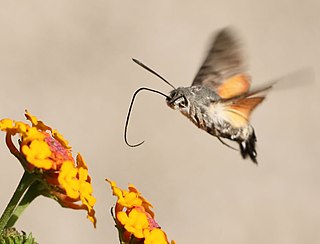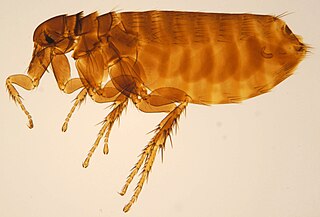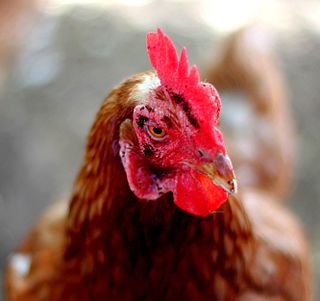
Flea, the common name for the order Siphonaptera, includes 2,500 species of small flightless insects that live as external parasites of mammals and birds. Fleas live by ingesting the blood of their hosts. Adult fleas grow to about 3 millimetres long, are usually brown, and have bodies that are "flattened" sideways or narrow, enabling them to move through their hosts' fur or feathers. They lack wings; their hind legs are extremely well adapted for jumping. Their claws keep them from being dislodged, and their mouthparts are adapted for piercing skin and sucking blood. They can leap 50 times their body length, a feat second only to jumps made by another group of insects, the superfamily of froghoppers. Flea larvae are worm-like, with no limbs; they have chewing mouthparts and feed on organic debris left on their hosts' skin.

Pipunculidae is a family of flies (Diptera) commonly termed big-headed flies, a reference to the large (holoptic) eyes, which cover nearly the entire head. The family is found worldwide and more than 1300 species have been described.

The Pyralinae are the typical subfamily of snout moths and occur essentially worldwide, in some cases aided by involuntary introduction by humans. They are rather rare in the Americas however, and their diversity in the Australian region is also limited. Altogether, this subfamily includes about 900 described species, but new ones continue to be discovered. Like many of their relatives in the superfamily Pyraloidea, the caterpillar larvae of many Pyralinae – and in some cases even the adults – have evolved the ability to use unusual foods for nutrition; a few of these can become harmful to humans as pests of stored goods.

Clausiliidae, also known by the common name door snails, is a taxonomic family of small, very elongate, mostly left-handed, air-breathing land snails, sinistral terrestrial pulmonate gastropod mollusks.

Enidae is a family of air-breathing land snails, terrestrial pulmonate gastropod mollusks.
Pheia is a genus of moths in the subfamily Arctiinae erected by Francis Walker in 1854.

Saurita is a genus of moths in the subfamily Arctiinae. The genus was erected by Gottlieb August Wilhelm Herrich-Schäffer in 1855.

Ambulycini is a tribe of moths of the family Sphingidae first described by Arthur Gardiner Butler in 1876.

Smerinthini is a tribe of moths of the family Sphingidae. The genus was erected by Augustus Radcliffe Grote and Herbert C. Robinson in 1865.

Sphingulini is a tribe of moths of the family Sphingidae. The tribe was described by Walter Rothschild and Karl Jordan in 1903.

Macroglossini is a tribe of moths of the family Sphingidae described by Thaddeus William Harris in 1839.

Deltocephalinae is a subfamily of leafhoppers. Deltocephalinae is the largest subfamily in the family Cicadellidae and is divided into 40 tribes, comprising over 925 genera, and over 6,700 described species.
Dasypsyllus is a widespread genus of fleas. Some of its members are found in bird nests, including the moorhen flea, D. gallinulae.

Pulex is a genus of fleas. It comprises seven species. One is the human flea, and five of the others are confined to the Nearctic and Neotropical realms.

Ceratophyllus is a widespread genus of fleas found in temperate climates. Some of its members include the chicken flea, Ceratophyllus gallinae, and the poultry flea, Ceratophyllus niger.

Echidnophaga is a genus of fleas. It includes species which are found in Africa, parts of Asia, southern Europe, and Australia. Fleas in this genus remain attached to their host in a single location for long periods of time, causing swelling and ulceration of tissue. To remain attach for long periods they use specialized mouthparts, which, compared to other fleas, are relatively much longer.
Hectopsylla is a genus of fleas in the family Hectopsyllidae that parasitize non-volant mammals, birds, and bats. The genus comprises thirteen species, six of which were described in whole or part by Karl Jordan between 1906–1942. Two of the species in Hectopsylla, H. psittaci and H. pulex, go under common names, with H. psittaci identified as the sticktight flea and H. pulex identified as the chiggerflea. Hastritter and Méndez (2000) consider the genus Rhynchopsyllus a junior system of the genus.

Nosopsyllus is a genus of fleas belonging to the family Ceratophyllidae.
Neopsylla is a genus of fleas belonging to the family Hystrichopsyllidae.














